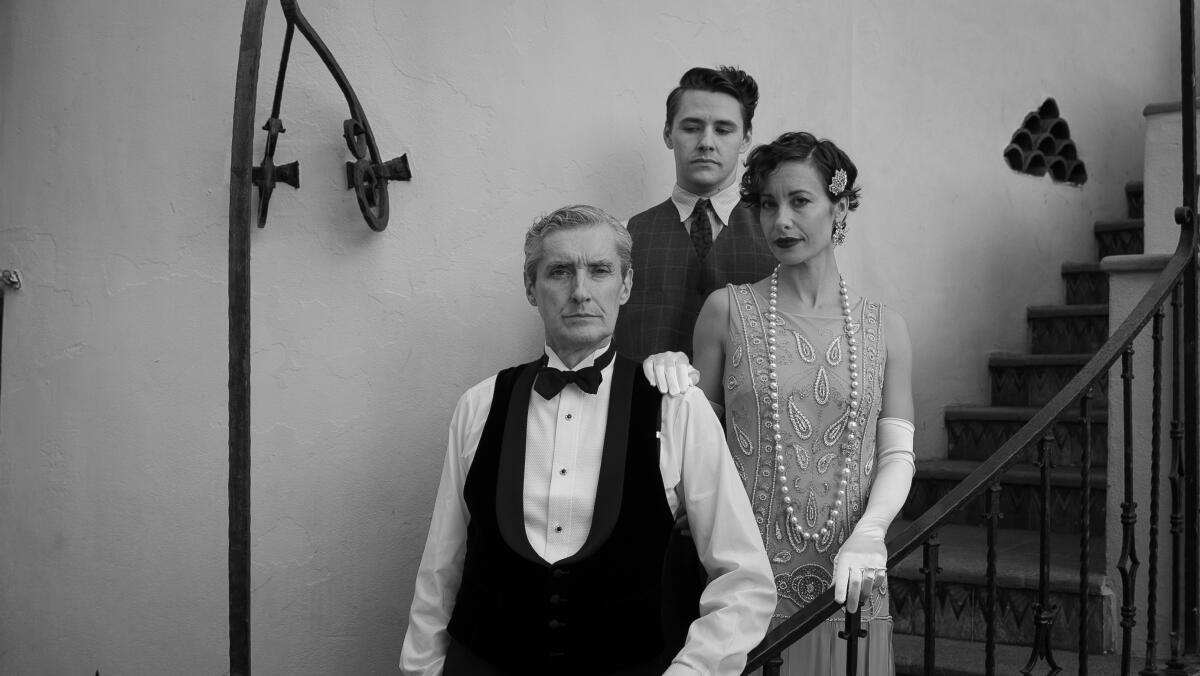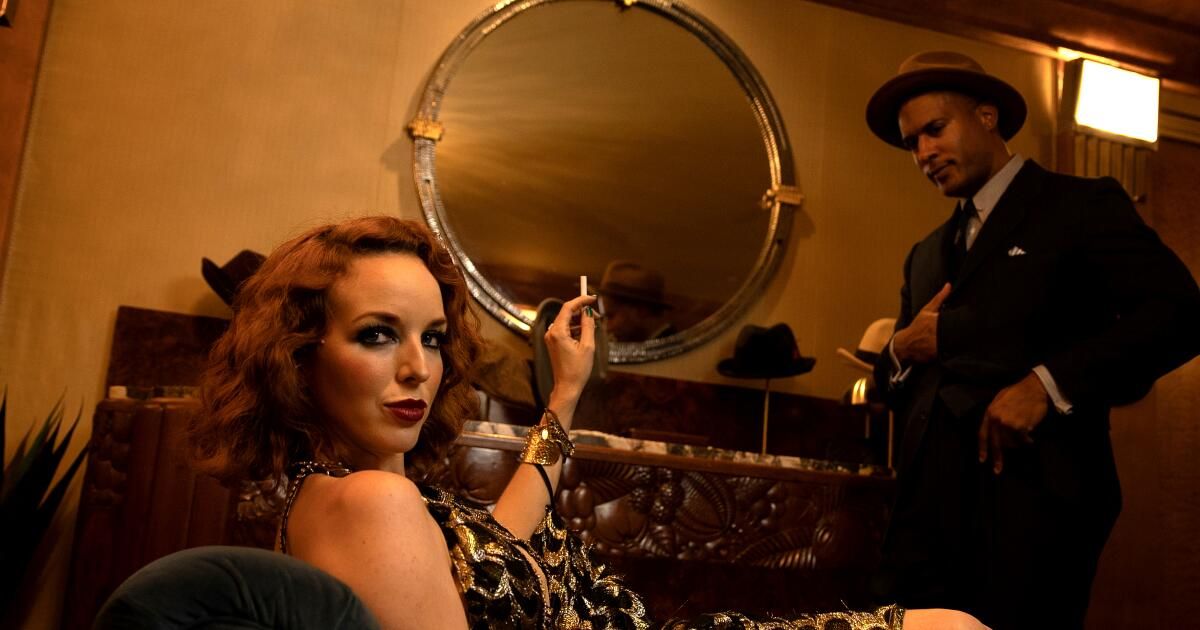In a story with loud and unlikable personalities, one character stands out: the setting.
Or, in this case, the Oviatt's 13th-floor penthouse, which is the setting for a new immersive theater production coming downtown this month. “Castle in the Sky” aims to tell a part of a nearly forgotten Los Angeles story: the jet-setting life of James Oviatt, the once-renowned silent film-era clothing manufacturer who had a long, slow career. fall from grace.
The show's name comes from the nickname of the Art Deco palace, which sits atop a building on Olive Street named after Oviatt. The penthouse is a collection of intimate rooms, each ornate and filled with personal, handcrafted details (some of them eccentric, like a small space designed to mimic a private carriage).
“Castle in the Sky” is designed for guests to follow certain actors from room to room during a party hosted by Oviatt. Each scene is short, about five minutes, and participants choose their own adventure throughout; They could, for example, spend the night following the actors playing Oviatt and his family or following other performers playing guests.
Equipped with French marble, zebra-skin bar stools, and exquisitely etched windows that block the view of the city center (a narcissistic move that seems to argue that what's inside matters more than the world beyond), Oviatt's penthouse is dedicated to the preservation of consumption. This article, from 1930, described the residence as “architecturally elegant, luxurious in detail, sumptuous and artistic in ornament.” The ground floor of the building, which now houses the Cicada Club, once housed Oviatt's prestigious clothing store, Alexander & Oviatt.
“Castle in the Sky” explores what kind of temperament it takes to create such a space, one equally dedicated to socializing and flaunting wealth with fragile accoutrements; those engraved windows came courtesy of, for example, the famous artist René Lalique. The story isn't pretty, but it also has to walk a delicate line. In his later years, Oviatt became known for his far-right views, so much so that he once described the racist and anti-Semitic Christian Defense League to this newspaper as “a great organization.”
The show explores the tension in a certain type of excess. There is a lonely desire to belong and it is contrasted with a distorted and offensive idea of immaculateness.
Chad Coe as silent film star Harold Davis and Connor McRaith as James Jr. in the immersive theater production “Castle in the Sky,” a Prohibition-era play described by one of its creators as a story of “ Eat the rich.”
(Zak Agha)
Oviatt's stories sometimes speak of his perfectionism with nostalgia rather than the bullying that it was. According to myth, he made the trip from his attic to the store early each morning, and theatrically dragged his white-gloved hands over the store's display cases in search of dust. The disappointment that followed is not said, but presumed.
“It's an eat-the-rich story,” says Tracy Phillips, one of three leads in the Under the Rose productions, of which the self-financed “Castle in the Sky” is their first show.
“I think it's the only way to handle someone like that,” adds Phillips, a longtime dance choreographer.
“Castle in the Sky” is set during the Prohibition era, when Oviatt was at the peak of its power and social prominence.
“The present does not look kindly on many people in history, particularly him, if you know anything about his unpleasant characteristics, to say the least. We didn't get there on the show, but we made sure to destroy it. “This is not a good guy,” Phillips says.
In addition to Phillips, Under the Rose is directed by Denna Thomsen and Kristin Campbell-Taylor, all veterans of various aspects of the Los Angeles dance community. “Castle in the Sky” was created in about six months, the three say, although they had been tinkering with an immersive concept inspired by the first Academy Awards in 1929 at the Hollywood Roosevelt before discovering Oviatt's story. When looking for places to host a production, they came across the Oviatt building and his penthouse and learned some of his history. They immediately changed course. “We were in space and it was so beautiful that it instantly transported you to a place,” says Campbell-Taylor.
Campbell-Taylor, a producer whose credits include “So You Think You Can Dance” and “The Masked Singer,” says the team was inspired by shows like “Sleep No More,” a long-running New York production that assigns guests the task of Reconstruct the narrative by following various scenes throughout the McKittrick Hotel. “Castle in the Sky” participants are invited to stay after the production for a post-show reception with a bar and live band; That's also a good time to socialize with strangers and discuss what scenes each of you missed.

“Castle in the Sky” explores the complicated and controversial life of James Oviatt. Pictured, from left, Circus-Szalewski as Oviatt, Connor McRaith as James Jr. and Nicole Pacent as Mary Oviatt.
(Under Rose productions)
“We worked very hard to weave and create narrative and emotion so you can understand it, even if you don't know what happened,” says Campbell-Taylor. “Our show is a deconstructed narrative, but it has a beginning, middle and end for each character, and a beginning, middle and end for the show itself.”
During my time with the show in its opening weekend – “Castle in the Sky” runs through Nov. 30 – I opted to take a look at each character's story rather than stick with a single performer for the duration. evening. I saw the isolation felt by Oviatt's wife, Mary (Nicole Pacent), the misguided attention sought by her son, James Jr. (Connor McRaith), and a performative marriage of Hollywood actors going up in flames.
The Oviatt I witnessed, played by Circus-Szalewski, was controlling, voyeuristic, and desperate, and it helped that I had read a little about Oviatt's true story before seeing “Castle in the Sky.” Knowing, for example, that he proposed to her wife, a former shop assistant half her age, after seeing her working in her store. Oviatt's name appeared regularly in this newspaper during the 1920s and 1930s. His annual trips to Europe in search of fashion inspiration made gossip headlines.
“James Oviatt was very transactional in all his relationships with everyone around him,” says Campbell-Taylor. “Both sides of those transactions were something we explored a lot.”
“Castle in the Sky” can be slightly interactive. For most of the PG-21 show, we are simply an audience, watching a bedroom seduction in one scene and the results of overindulgence at a party in another. (Oviatt during Prohibition is said to have had a nearly endless supply of alcohol, making her parties some of the most sought-after venues in town.) But there are times when we may be talked to or find ourselves engaging in a game of rock, paper, scissors with other attendees.
Other scenes, however, are purely performative and take advantage of Phillips and Thomsen's experience in experimental dance choreography. One features a character shaving, the daily task treated as if it were a delicate dance on top of a music box.
In other words, don't expect any big Charleston-inspired dance numbers. “That's something we've all seen before,” Phillips says. “It was a challenge to stay within the era, but they were full people. They didn't just do the Charleston. That's just a small thing that has persisted. “They had full lives and we wanted to express that through dance and acting without falling into novelty.”
The hope is that “Castle in the Sky” doesn't feel solely like a period piece, despite the costumes and attic aesthetic. After all, its themes, centered on the power vacuum (and the vapidity of those who seek to be close to it), are timeless, especially in this city.
“We put you in the present, even though we're telling a story about the past,” Phillips says.












